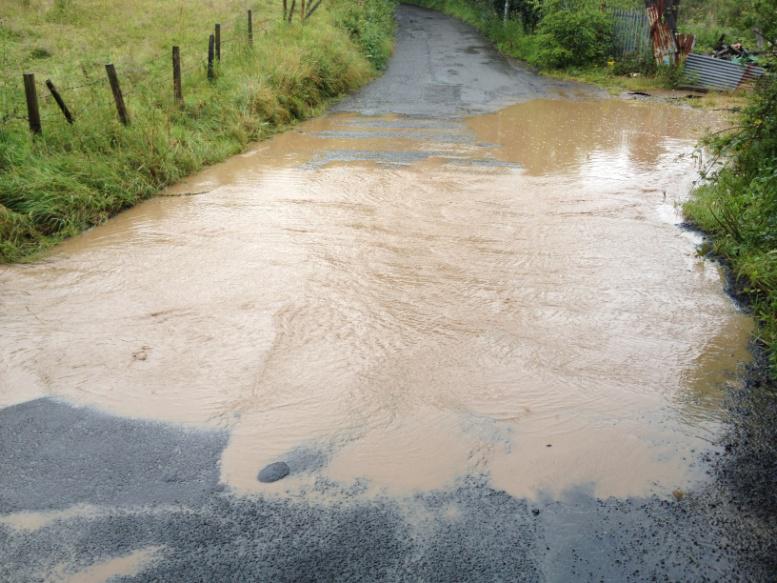Your basket is currently empty!
2013 Newsletter
Words from The Chairman
As we near the start of another season for the River Kelvin Angling Association, I feel that it is useful to reflect on the season past, and give my views and thoughts on the successes, failures and expectations that the season brought.
As is the norm for the Kelvin, spring fish were evident, but not in any numbers. However, given the level of fishing effort, it is, once again, difficult to form an accurate estimation of the numbers of these elusive early fish, and I urge members to be out on the river during the spring of 2013, as it is only with a regular angling presence on the river that we will ever be able to have an accurate estimation of the numbers of spring fish entering the river. However, I did hear news of a 12lb springer caught on the 23rd March, with another lost by the same angler. Throughout March, April and May there were a few fish caught each one a perfect “bar of silver” in mint condition straight off the tide. Unfortunately, and for yet another season, the Kelvin springer eluded my efforts, but I was rewarded with a lovely 7lb’er at 11am on the 1st of June, just a few hours after a fish can officially be termed a “springer”!! Conditions in the spring of 2012 were variable to say the least with consistent rain during March followed by a period of unseasonably warm weather, both of which made fishing conditions less than ideal.
As May progressed and the longer days of June meant more hours on the river, numbers fish were being caught from the pools on the lower river. June saw the arrival of good runs of multi sea winter fish with fine specimens of between 8 and 14lb’s being caught. By the end of June and into July runs steadily increased and good catches made, with the first of the grilse starting to make an appearance. Heavy, persistent rain was a common occurrence, and fish were streaming into the river off every tide. Catches at this time were excellent, but the fish were reluctant to take advantage of the good water, and seemed to be concentrated in the pools on the lower river. On the two occasions that I ventured to the middle / upper reaches, I was met by fishers complaining of the lack of fish on these stretches, were the fish holed up in the lower / middle pools, or had the surplus of water encouraged them to run hard for the spawning grounds while they had the opportunity? Again, I was reminded of how weather dependent our sport is, and how fickle our quarry! However, during this period I did manage to land 6 of these fine specimens with many more lost, so I can’t complain. It only confirms advice that I would pass on to any new member wishing to catch a salmon on the Kelvin – “if you want a big, fresh fish then concentrate your efforts in the months of May and June” The biggest fish that I heard of being landed during this period was 15lb, but other fishers (myself included) reported having lost fish that they suspected were much larger.
As the summer progressed the river was up and down like a yoyo, barely settling after one spate before being flooded by another. As any seasoned salmon fisher knows, these types of conditions are hardly conducive to good fishing and the catches during August and September certainly reflected this. All we can hope for is that the good number of fish that ran the river made it safely to the spawning grounds, and that this will be reflected in the spring’s smolt run. With the river being in a constant state of flux for much of the summer, the successful fisher carefully picked his days when conditions were more settled and fish more willing to rest in the pools long enough to give us half a chance of connecting with them. Personally, I did not manage as much time on the river as I would have liked and only managed one more fish for my season. However, I do know of one fisher who continued to catch fish into September / October, but only by being selective of when and where he fished.
I hope that members have noticed the amount of work being carried out by The Association this season. Regular work parties have been carrying bank side improvement works, and have successfully opened up large sections of river that had previously been unfishable. These work parties have continued over the closed season, and I urge those who have not been out to make the effort and assist in creating more fishing for the members. Congestion in certain stretches has always been an issue on the river, and I, for one, am convinced that we are only fishing around 30% of our river. The Association has purchased all the necessary tools to improve access, and it is amazing the amount of new water that can be opened up by a few bodies in one afternoon’s work. It will be a long process, but ultimately it will be worth it, and will provide members with a much more enjoyable fishing experience. On a larger scale, the Association, in partnership with the Clyde River Foundation (CRF), is currently working on a funding bid for the River Restoration Fund, where our aim will be to restore the river to its former glory before industrialisation and the flood prevention measures of the 1960’s. This is a long term aim that will take a great deal of work on the part of the Association and the CRF, but will result in an increase in not only the fishings, but in habitat for spawning and juvenile fish.
All that is left for me is to wish all members a happy and productive season for 2013,
Alan Atkins – Chairman, River Kelvin Angling Assocciation
Vice Chairs Report
The 2012 trout season could firmly be split into two for the trout fisher. Spring and early summer were excellent with anglers reporting trout of up to 14-15 inches on a regular basis and then after June it totally dive-bombed and we were left with high water levels which displayed a weird clay colour which I will talk about later.
So early spring and summer I learned not just from my own catches but from others the trout were responding well to dries as well as nymphs. I noted a real increase in the size of trout and several anglers I met on the riverbank have commented on this. This may be attributed to a few factors: the early spring resulted in better conditioned trout due to increased insect activity, the non-stocking policy has now started having an effect allowing the indigenous trout to repopulate and move into the better habitat that the stocked fish were holding in and the ban on killing trout means simply they are actually getting a chance to breed.
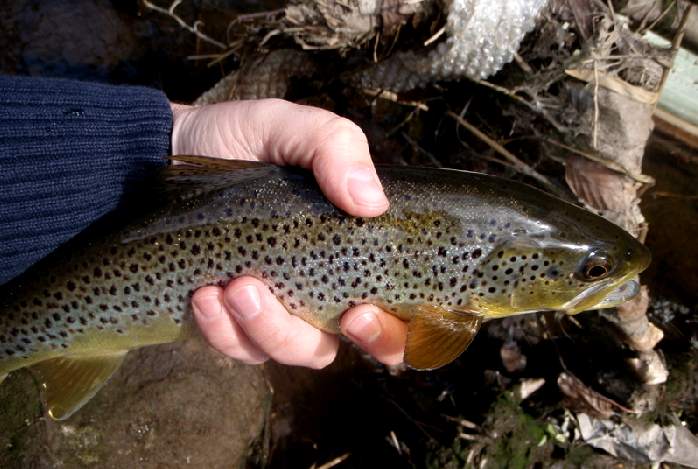
After June the rains came and trout fishing dropped off due to the high water, even when it had not rained in a day a short shower would cause it to dirty up and raise a foot in under an hour. I noticed though that when the river was at a fishable level for a few days the water had taken on a clay colour which really should have dissipated quicker, Paul Reid did some investigating and found that up in the Luggie there was water coming from a building site that had high levels of clay in it due to the large amounts of rain. There was really nothing anyone could do about it. Throughout this time it was difficult to get a trout to respond to a dry fly although the nymph was still productive.
Several days a week I have been running along the banks of the Kelvin and have met a few anglers, some appear surprised that I would ask them for permits while not actually fishing. The majority have had permits and are happy to chat however I have met some guys without permits and they have been told to leave the river and given a letter detailing exactly why they must buy a permit as they are stealing from you them members. It is every member’s right to ask for permits and no member should be annoyed at anyone asking to see their permit. This is now the third season we have had a fly only rule on a Sunday which means that those illegally fishing for Salmon are now a lot easier to spot. I met a few guys in 2012 fishing with spinning rods on a Sunday and they all appeared genuinely surprised at the rule, can you ensure you remind your fellow association members of the rule as in 2013 their permits will simply be taken from them.
Anyway, on a lighter note as I write this the weather is mild with temps around 9 degrees and even though Spring is yet to come if the winter keeps mild like this we can look forward to an even better season than last as long as it does not rain constantly. Top flies in 2012 for me were Olive Comparaduns, klinkhammers and micro gnats for dusk. I predict the same flies will do for 2013.
I only managed one of the work party days however they have been very productive with large areas cleared – if there is an area that you feel requires attention please let us know.
Have a great season and if anyone fancies having a chat about the river and fishing do not hesitate to contact us through the site.
Kind regards
Alistair – Vice Chair

Headline Figures
535 members
195 returns submitted in time
272 migratory fish caught (returns submitted before 20th November).
70% of migratory fish returned
Fishkelvin.com
The website has been up and running for a couple of years now and we would welcome some input on how we can develop it further. There is a project to provide a digital map (more details to follow), but if there is anything else you would like to see please let us know. Currently the forum allows members to submit any queries or suggestions that they might have, but I personally feel the site is under used in general. I will endeavor to post quarterly news letters this year along with work party updates and pictures, but it would also be good if we could get members to report any catches and submit pictures.
The Luggie Water
Midway through last season the Committee were approached by the Crown Estate’s representatives regarding the salmon and fresh water fish lease for the Luggie Water. The club that previously held the lease could no longer afford to continue and we were asked whether we wanted to take it on before it was to be offered to any other parties. Under the powers granted to them in the constitution the Committee decided to take up this offer on behalf of the Association. The logic was simple. There are three main tributaries to the Kelvin. The Allander, which is already controlled by the RKAA and contributes greatly to the numbers of fish returning to the river. The Glazert, well managed by Campsie Angling Club and also contributes large numbers of fish to the Kelvin. The Luggie, easily the biggest of the three tributaries but currently spawning levels are low. Having control of your headwaters is an obvious benefit to any forward thinking Association that wishes to make serious habitat improvements, and therefore increase runs of migratory fish. Simple arithmetic would suggest that if we can get the Luggie up to the same standard as the Allander and the Glazert, then we could potentially improve runs by a third!
My own experience of trout fishing on the Luggie last season is that the quality of the fish appears to be excellent, and I fully intend to be out more in 2013.

Jim Burns Bridge
In April a crack team of civil engineers were nowhere to be found, so instead a rag tag group of committee members decided to place a bridge across a feeder burn at the Pylon Pool on the Balmore stretch. The previous crossing (a metal plank) was no longer a safe route due to bank erosion, and getting over the burn was beginning to become a fairly dangerous undertaking. Jim Burns (Treasurer) managed to get hold of a couple of railway sleepers, and fabricated a bridge complete with hand rails in his back garden. All that remained was to get the bridge transported and installed. A brief meeting with the farmer meant we could use James Crainey’s 4×4 and trailer to get as near as possible, the rest was just about humphing it over the fence and down to the river’s edge. I’m glad we attempted this in April when the ground was reasonably dry. Any later and the field would have been a sea of mud! As you can see from the pictures the mission was a success. Thanks to everyone that helped.

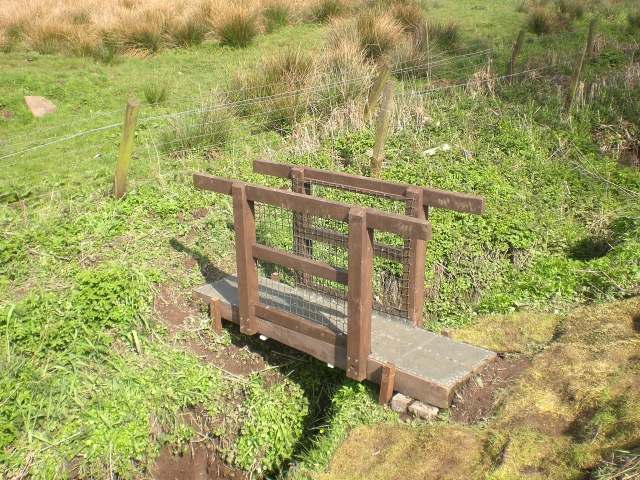
River Webcam
This is currently on hold while the contractor revises their funding model. I should have more information in the summer, but we still expect to have this in place at some point in the near future.
Scottish Minister Appointed Bailiffs
Currently we have 4 bailiffs with warrant cards, and a further 3 expected to sit the exam this year. These bailiffs will be part of the catchment wide RCFMT bailiff task force, which now has over 40 team members. Working together the aim of the task force is to hit problem areas in numbers and take action against those that choose to fish illegally. The plan is to have these sessions once a month. When the Kelvin bailiffs are not working with the task force they will be out on the river as much as possible. The bailiffs have powers of search, seizure and arrest, but it is important to note that they are all volunteers. I have personally been involved as part of this team and I fully expect that there will charges brought against known problem makers this year, and possibly vehicle seizures. Hopefully this will send out the correct message to any poachers or ‘opportunists’ that are considering the Kelvin as a place to visit.
American Signal Crayfish
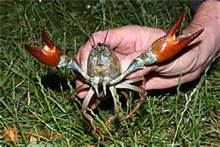
We have received no reports of any sightings this year. The Clyde River Foundation is continuing to monitor the distribution of crayfish locally and sightings should be communicated to Willie Yeomans (w.yeomans@bio.gla.ac.uk) asap (telephone: 0141 330 5080). All specimens captured should be humanely killed (it is acceptable to crush them quickly underfoot) – do not put them back into the river. It is illegal to be in possession of live crayfish without a licence, so please do not remove any from the riverbank.
Catch Returns
To only have 195 catch returns submitted before the 20th of November deadline is very disappointing. This is the last year that we will have an amnesty for those that submit after the agreed date. From now on those that submit late, or not at all, will be expected to join as new members the following year. This means that they will incur the joining fee. Currently the joining fee is £10, but we have a proposal to raise this further. I will be backing the proposal as I believe it will help to ensure members complete their returns in a timely manner. It will also help to generate more revenue for the Association. Anyone that did not submit a return for the 2012 season will be asked to pay the joining fee for the season ahead.
There are some anglers that believe catch returns can result in higher angling fees, while there is an element of truth in this (especially for established salmon rivers) for the Kelvin it does not apply. As a recovering salmon river running through a very built up area, our lease will always be lower relative to other rivers, and numbers of fish caught do not alter the cost one year to the next.
To give an example of why an accurate catch return is so important. Say we average returns of 200 migratory fish a year, but in reality the catch is nearer 400. If the following year the catch return is 180 and the figure is accurate, then the statistics will show a fall of 10%, when in reality the figure is closer to 55%. While we will get very little assistance tackling a 10% variance, a 55% drop shows a significant problem and one worth looking into if it goes against the trend of other rivers. While this example might be over simplified, completing a catch return is very important because we need accurate records if we are going to be able to spot trends and tackle issues before they become catastrophic. Thanks to everyone that submitted a return this year, and please remember that nil returns, i.e. you didn’t catch anything, must still be submitted.

Habitat Survey
Alan and I recently attended a meeting with the CRF where the Habitat Survey was used to identify problem areas within the system, and therefore highlight where and what we should be doing to make improvements. The take away message from the survey is that there are large sections of water that may look ok to the untrained eye, but in reality they may only offer habitat to one stage of a salmon or trout’s life cycle. As such the lack of changing habitat is almost as bad as no habitat at all. It was very interesting to hear just how often we need the habitat to change, and what combinations you need to maximise fish production. Without the Habitat Survey we would have been fumbling in the dark, trying to improve areas that ultimately would have no effect due to the isolating nature of the upstream and downstream stretches. The result of the meeting is that we are now beginning to put together a river restoration project and are currently looking for funding to start works in particular areas. It is interesting to note that in order to get funding we have to tick a lot of different boxes, and often the funding provider will only fund works in particular areas. Luckily the CRF are experts in this area and are helping us apply to the relevant bodies. Already the CRF have a student looking into the original course of the river and exactly how much habitat has been lost through change. This will help us when it comes to applying to the likes of the River Restoration Fund.
Pollution Incidents
Following reports of persistent discolouration, I had a walk up the river late in the summer to see if I could identify the problem. It was evident that the colour was coming from the Luggie Water and further investigation identified a number of issues. These were reported to SEPA and I received the following response:
Sewage odour, Luggie Water: This was due to a problem with Scottish Water’s Glenluggie pumping station. We reported this to them and they resolved the problem. We asked them to remove any sewage related debris downstream of the outfall. I will inspect this again next week to ensure the action they advised remains effective.
Discolouration in Luggie and Bothlin: We held discussions with Allma Construction and representatives of the Woodilee development prior to and during the phase 1 and 2 construction. This involved an assessment of their surface water drainage for both the construction and completion phases. We have requested they make improvements to the construction phase surface water drainage due to pollution caused by run off from exposed soils at the land off both parts of the site near Calfmuir and Market Road and the rear of Bridgeway Road. We have commented on how effective we believe their surface water pollution prevention to be as initially this was not acceptable.
There were recent problems caused by a burst water main on the land bounded by Calfmuir Road.Market Road. This resulted in run off entering the Bothlin. Allma believed they had tackled the problem but we showed them run off entering the Bothlin and requested they improve matters. As part of their approach they are pumping some flow into the sewer.
We continue to monitor the Luggie and Bothlin downstream of the sites and our Ecology section will assess impact. Due to the length of time the construction phase is due to take, coupled to current concerns, we will return to site periodically to assess effectiveness of the surface water drainage systems. If it is found to be ineffective we will consider appropriate enforcement action.
You had concerns over the ponds associated with the phase 1 development. I recently inspected the one near Larkfield, Lenzie, to the left of the entrance to Woodilee development main entrance and the one at the back of the development adjacent to the Old Ailse cemetery footpath. These ponds are to treat completed phase surface water drainage. Although they appear cloudy, these are the main sections of the pond for sediment deposition, designed to provide sufficient retention time to drop sediment out. Close inspection revealed these ponds are effective at dealing with surface water run off. I inspected the outlets and the discharges were not of concern. There was no discoloured run off from either pond into the Luggie.
If you require to discuss this further please do not hesitate to contact me.
We have had a number of incidents recorded this season. Changes to the climate could mean increased problems due to saturated conditions and a sewage system that can’t cope. It is therefore very important that we all monitor the river and report anything that we believe to be an issue. Don’t wait for someone else to discover the problem, and please don’t assume that it has already been reported. With regards to CSOs (combined sewage outflows) it is the frequency of the problem that is important, not just the incident itself. So the general message is to report to SEPA every time, and notify the committee in order that we can collate the information and follow up.
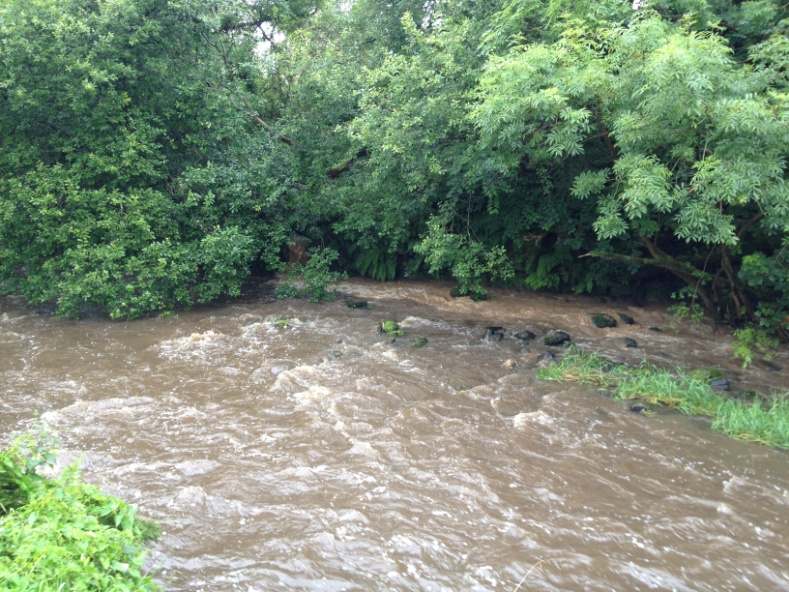
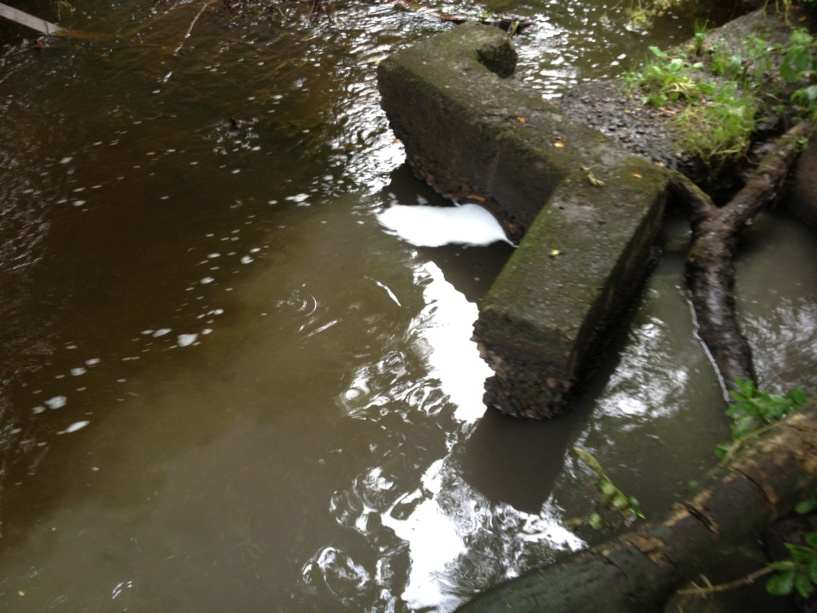
Work Parties
It has been a busy year for those that regularly attend the work parties, we have had around 12 organised days for volunteers and I would like to thank everyone that has come along. Work carried out has ranged from litter picking to full blown tree removal and everything in between. At the beginning of the year we worked with FORK to open up some areas around the Botanics and the Tree Pool. We also opened up the White House pool, and I have high expectations for this under fished pool next season! We have also carried out extensive work in Kinrkintilloch, as well as above and below Balmore Bridge. As Alan has already said, a lot of fishing has been opened up so please take advantage. For information on how you can get involved, please keep an eye on www.fishkelvin.com. It’s really just a case of turning up and getting stuck in. The more people volunteer, the more we can achieve. Fizzy pop and snacks are provided, the next session is on Saturday the 2nd of February, meeting at Kelvindale Road Bridge.
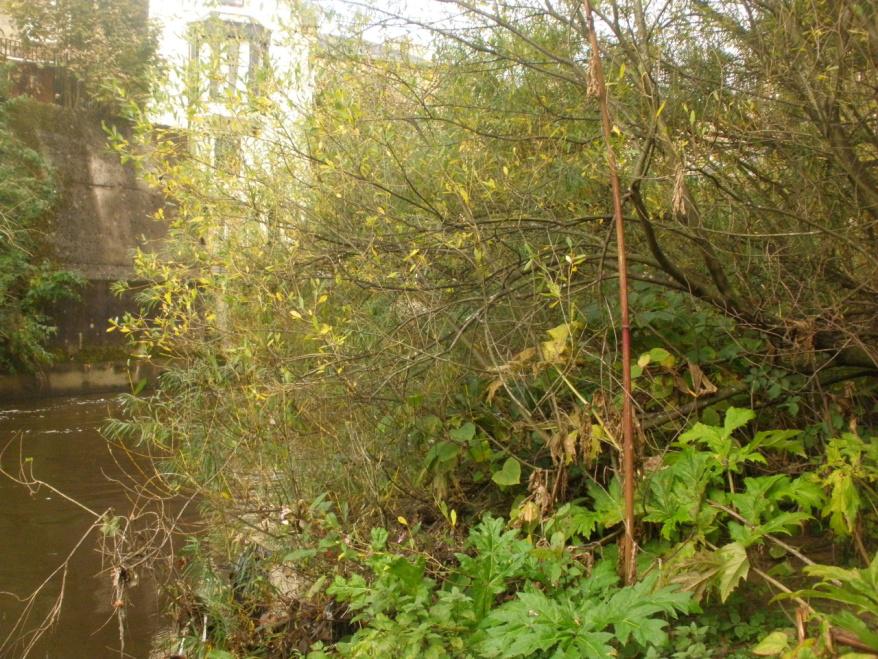
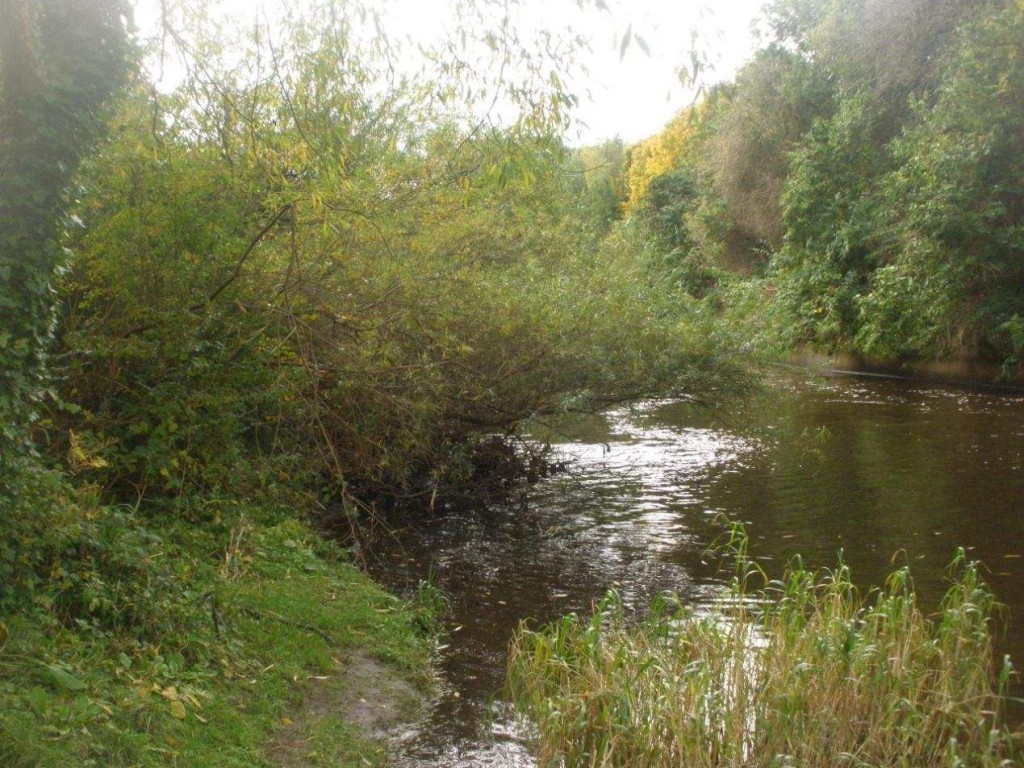
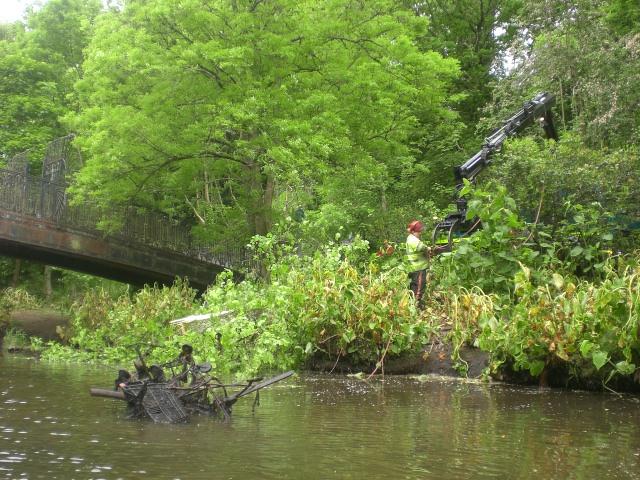
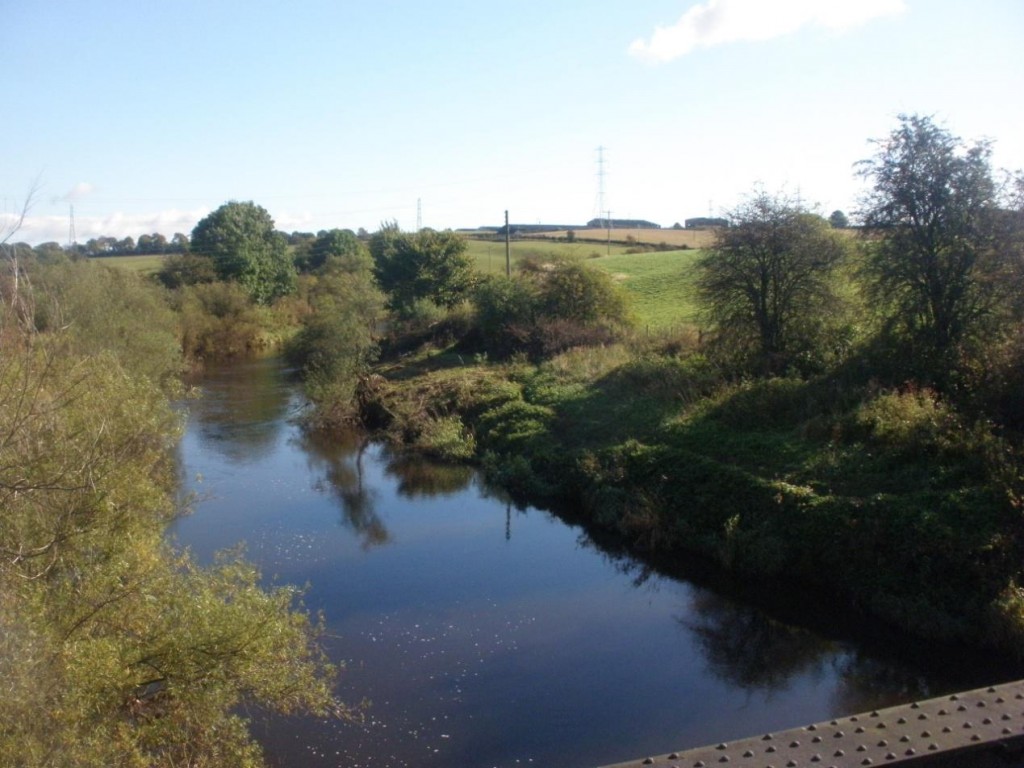
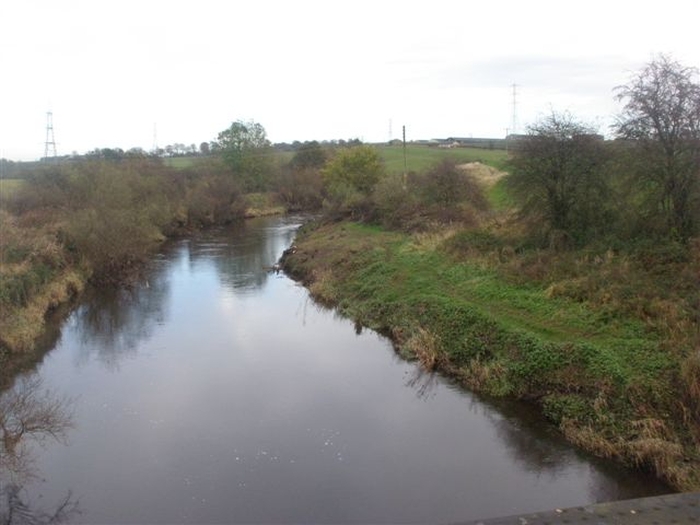
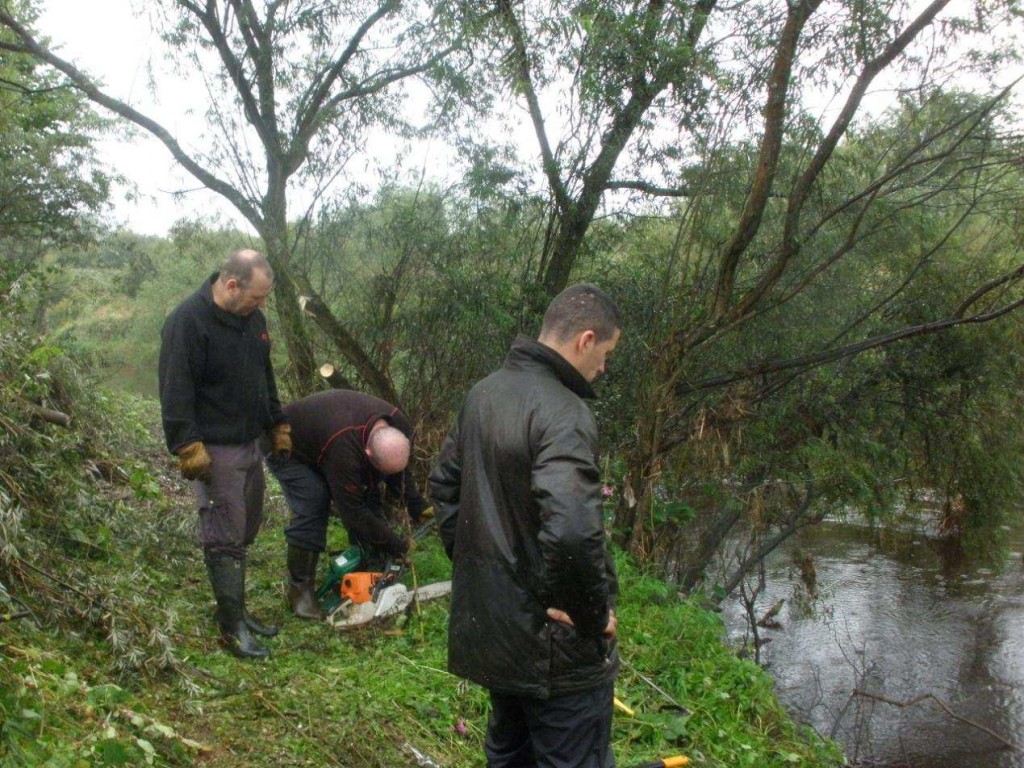
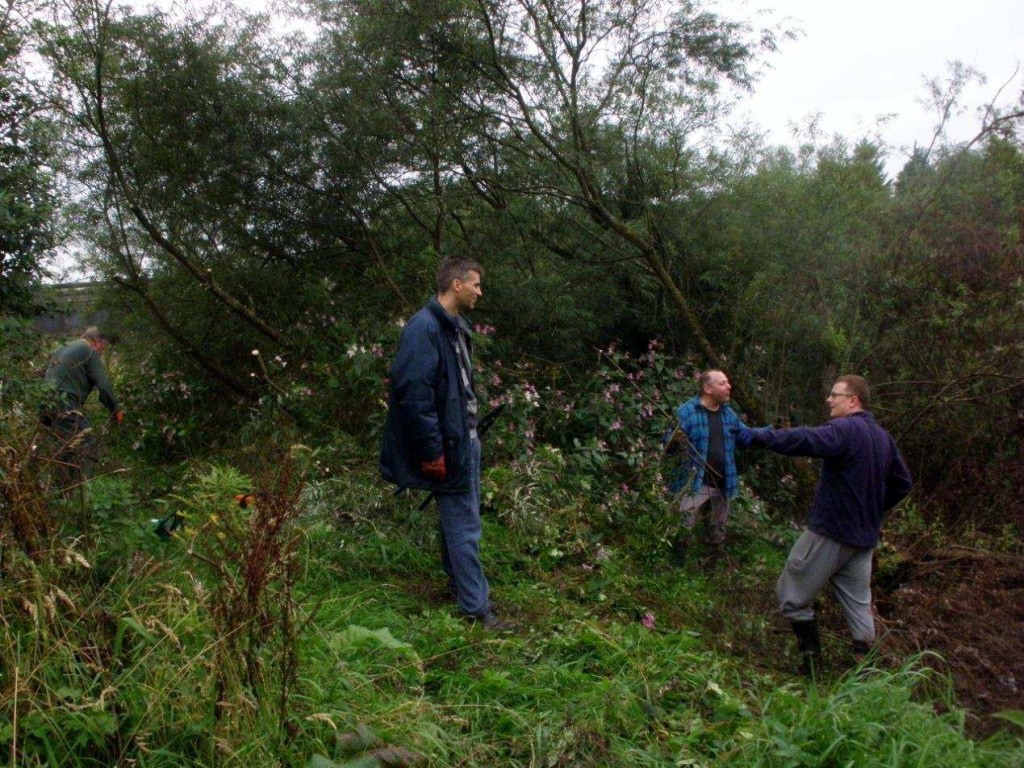
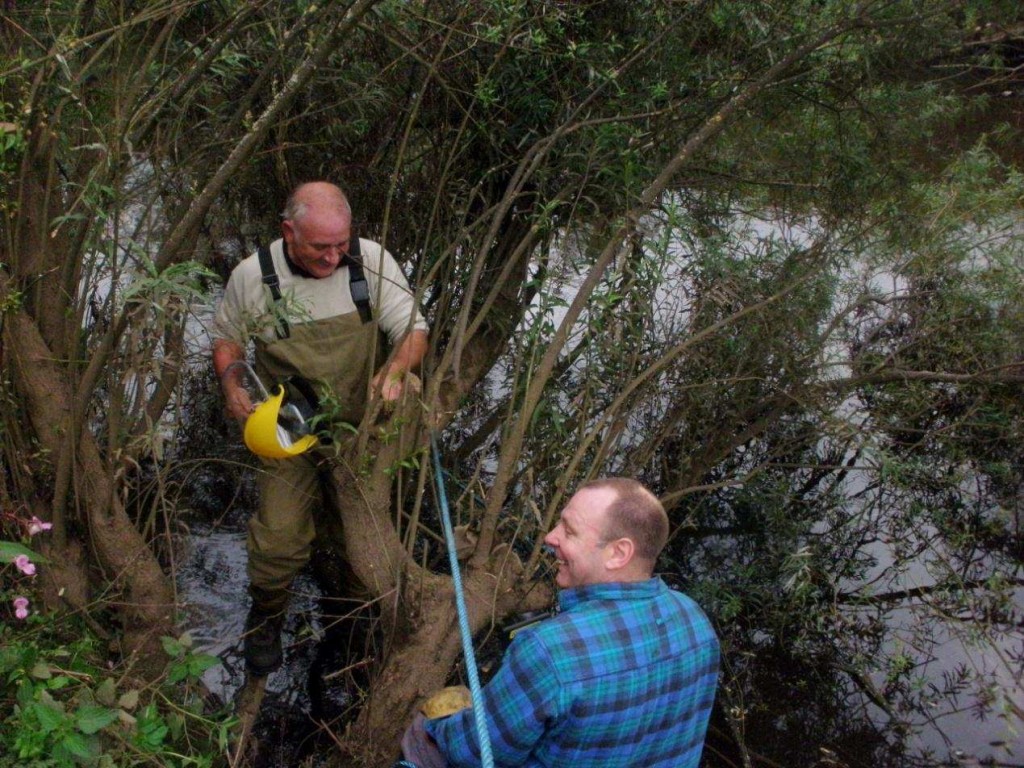
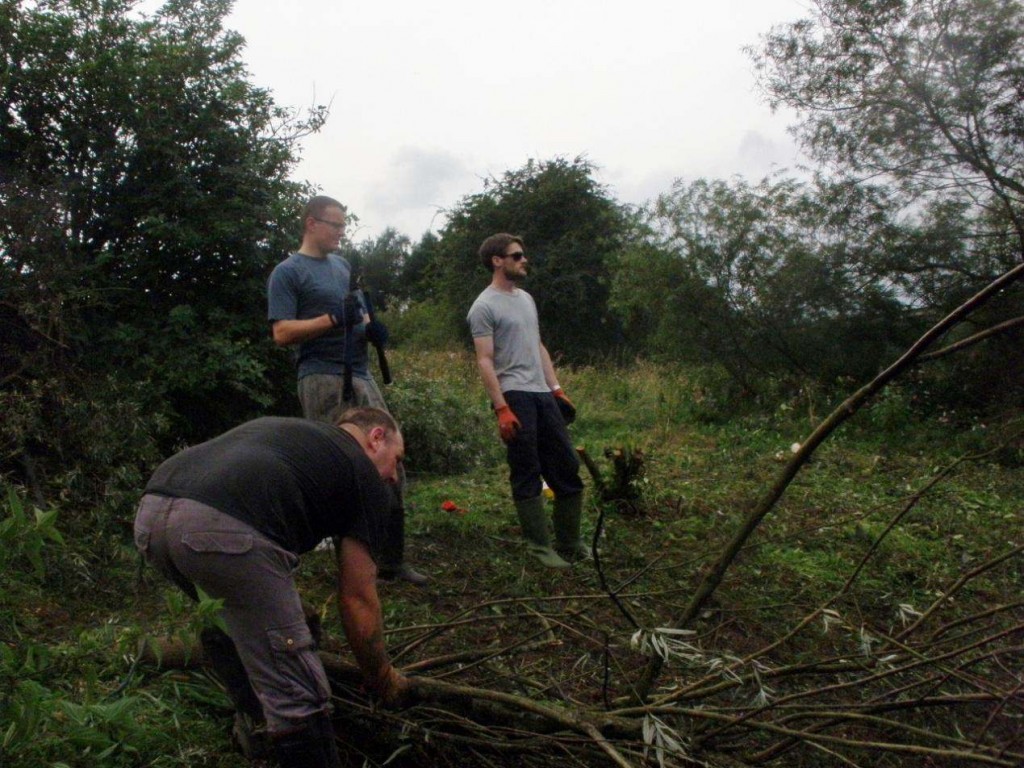
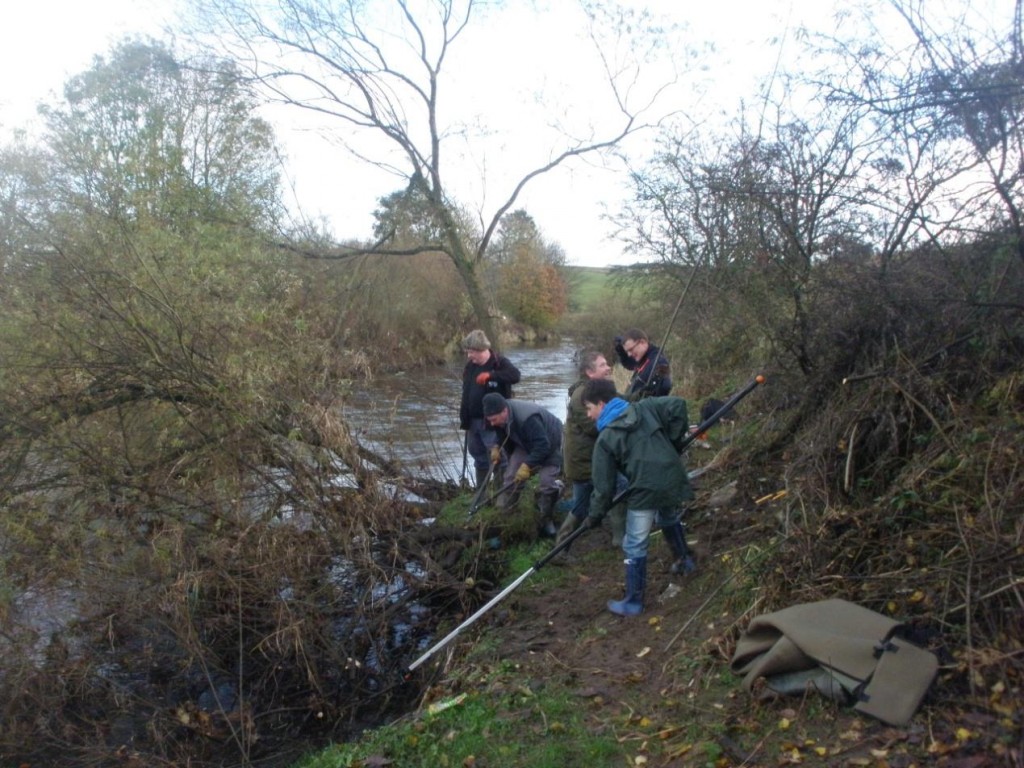
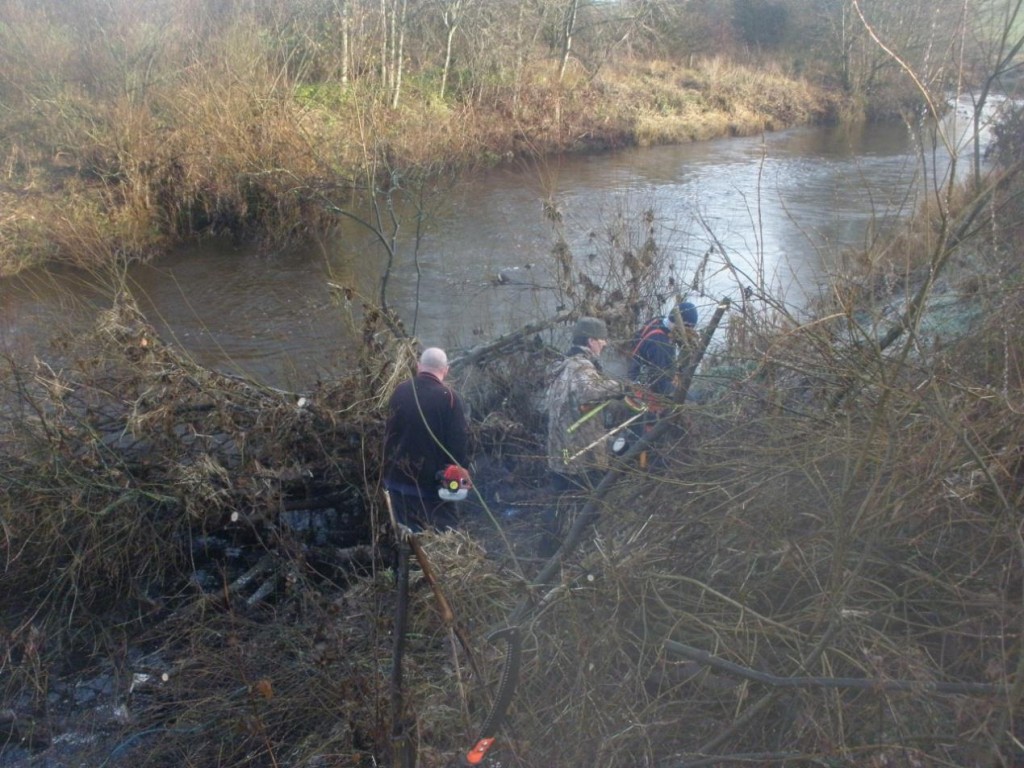
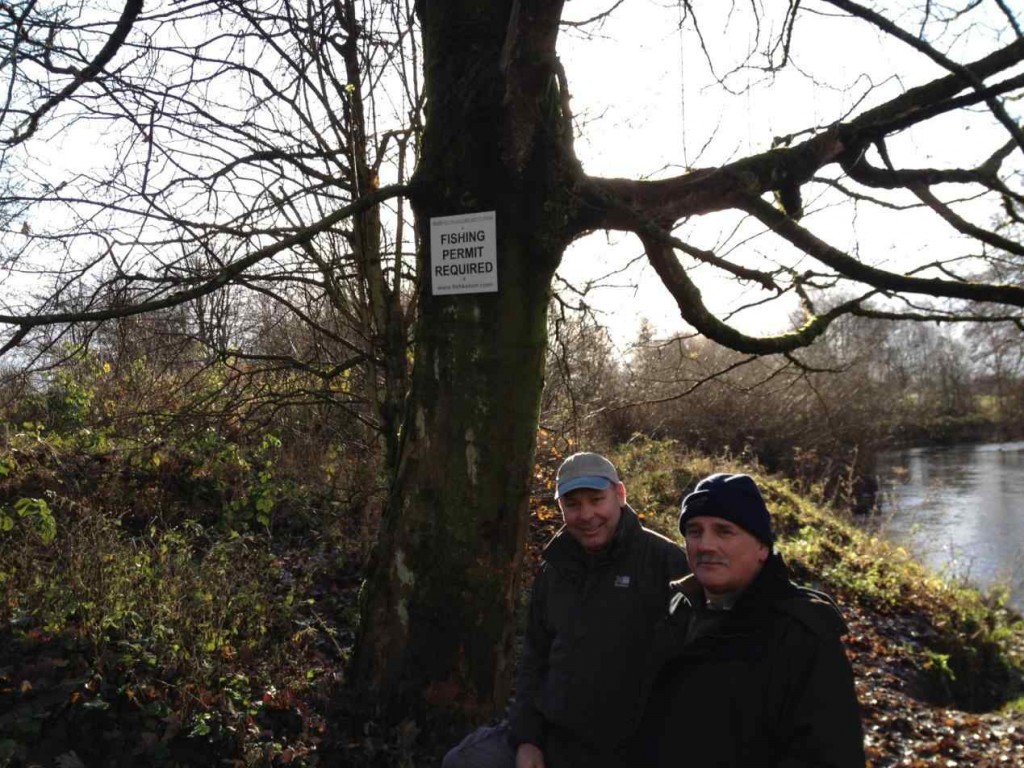
Otago Lane
Recently the Committee were made aware of a proposed development on Otago Lane which could potentially affect the Kelvin. For more information please visit www.saveotagolane.co.uk, the following extract is from their site:
Developer Hugh Scott has now applied for the Kelvin River Wildlife/Green corridor to be repealed.
Under his company, Highlander House, the developer has submitted proposals to GCC to end the Kelvin River wildlife corridor, which runs along the river bank linking Kelvingrove Park to the Botanic Gardens.
Recently Labour councilors on the council’s planning applications committee voted unanimously to grant plans to build an unprecedentedly large building complex on Otago Lane. Residents and business owners have been exploring legal options so as to challenge the decision. Amongst a myriad of breaches of protocol and planning policy it appears the designated corridor was completely ignored as an issue in the report to the planning committee, along with the relevant rules protecting green space. This provides strong grounds for taking the decision to grant to judicial review. We believe that the developer plans to neutralize this as an issue by proposing the annulment of the wildlife corridor, another backdoor tactic. As we know from experience, the DRS cannot be relied upon to protect the heritage and wildlife of this city. We need your support now to object to this proposal, to protect the environment and Otago Lane.
The Committee have submitted an objection on behalf of the Association, and have raised the matter with a local councillor.
Anglers Monitoring Initiative
This nationally endorsed initiative was developed from the pioneering monitoring work carried out by Dr Cyril Bennett on the River Wey. The AMI responds to the demonstrated demand from individuals and groups to pursue an interest in riverflies and have an informed dialogue on the biological water quality of their local rivers with the statutory bodies. The programme trains interested groups at one-day workshops to monitor the water quality of their local rivers, using a standard 3 minute kick sample as used by the Environment Agency (EA)/Scottish Environment Protection Agency (SEPA) and recording the presence and abundance of seven groups of riverflies. The riverflies are pollution sensitive and are commonly heralded as the canary of our rivers.
The benefits of the initiative include:
- directly identifying falls in water quality and alerting the EA/SEPA to further investigation;
- acting as a deterrent to incidental polluters;
- and generating long term datasets on the biological water quality of UK rivers that can be used to monitor change.
Within a year of the national launch of the initiative there are more than 300 sample sites being monitored regularly across the UK. Case studies show how pollution events first identified by the Monitoring Groups have led to successful EA prosecutions of the companies responsible, and demonstrate the effective collaboration between the monitoring groups and the statutory bodies in helping to ensure the good ecological status of our rivers as required by the Water Framework Directive. The initiative is commonly cited as an example of best practice in conservation and the effective partnership of citizen scientists and statutory bodies.
The CRF will be running this initiative on the Kelvin, and will be looking for volunteers very soon. You will be trained and given equipment, after that you only have to complete a kick sample once a month. This is a real opportunity to do your bit for the river Kelvin. Please contact the Secretary to find out more.
Housekeeping
In the interest of making it easier for the volunteer bailiffs to carry out their duties, and make fishing a more pleasant experience for all association members, there are one or two matters the committee would like to address.
- Fishing without a photograph on your permit – there have been a number of issues this season with people fishing without having their photo on their permit. This makes life difficult for bailiffs who might not recognise you as a member. We have amended the permit card to show that the permit is invalid without a photograph, or without being properly sealed.
- Set lining – Although this is illegal under the Salmon and Fresh Water Fisheries Act, it continues to be an issue. For those that might not be fully aware, putting your rod down on a stick / rod rest / stone while your bait/lure/fly is in the water, is considered an offence. Not only is this a fairly unproductive way to fish, it is also extremely bad manners as fishing etiquette (and the association rules) dictates that you should take a step between each cast. Using a chair or lying down on the ground means that you are not moving through the pool as required, this prevents access for other anglers and is a major source of frustration for association members. If there is no one else around you might think it is ok to sit in the one place, but other anglers might come along and be put off by the fact that you are clearly not moving. These anglers then assume that this sort of behaviour is acceptable to the association and a vicious circle ensues. The attitude towards the bailiffs that are trying to eradicate this has been poor to say the least. The bailiffs have a duty to make sure that no one is breaking the law, any future incidents whereby an angler complains when they are asked to move or any angler that continues to set line, will be asked to leave the association.
- Fishing from weirs/falls – Feedback from members suggests that last years warning was not heeded, in particular I refer to the Falls Pool at Bishops Mill. There have been several complaints regarding angling etiquette, and we have been asked to take action. There will be at least one proposal at the AGM aimed at tackling this problem.
- Litter and fires – Both are unacceptable and leave an unsightly mess which is both unpleasant for other association members, and potentially damaging when it comes to the reputation of the association and our sport as a whole. The committee notes that there are at least three specific areas where litter can be attributed to anglers and that it is becoming an issue for anglers and land owners alike. Association members are encouraged to inform the committee if they have any information regarding the people responsible. Two anglers have already been sanctioned as a result of building fires next to the river.
- Parking – There have been complaints from residents relating to anglers parking in the residents car park next to the Falls Pool / Bishops Mill. Any Association member parking hear without written permission will have their membership revoked.
- AGM – This should be an opportunity to find out what is happening within your Association, and to have your say (through a vote) on how you want things to move forwards. It is not an opportunity to have a rant or a moan. Plenty of opportunity has been provided for you to express your feelings, the AGM is not the time or the place. Previously the AGM has been reduced to a rabble by individuals that do not seem to know how to behave at such occasions. No More! The rules are clear. Raise your opinions and proposals in advance. Listen to the information delivered. Vote accordingly. Speak if you are invited to do so, but do not talk over others. Any one that cannot stick to this will have great difficulty renewing their membership. For the record, anyone believed to be under the influence of alcohol or drugs will be removed from the hall.
Plans for the 2013 Season
Map Project
There is an old geographic plan of the Kelvin Catchment available on the fishkelvin site, however the detail is poor due to the scale. The sheer size of the fishing available through the association makes any attempt to map pools and runs a huge task. Anything we produced would probably take up enough pages to form a small book rather than a map. With this in mind we are looking to set up a digital map which people can access through the web site and print off areas of interest (some many even be able to access it through their phones). The idea is that we will use Google Maps and set up tags that will allow people to see pools etc. in more detail. This should allow us to pictures and perhaps information on how to fish and where to park. A further possibility is that people could like photos of their captures to the area where the fish was caught. Anyway, watch this space.
The Luggie
We aim to meet with SEPA and Scottish Water and discuss the best way to improve the water quality of the Luggie and the Bothlin Burn. Using the example from the River Carron (Forth District), we hope to create an action group that can help create awareness of the issues and ultimately get the work carried out that will deliver improvement.
Habitat Work
As mentioned already, we plan to start work on habitat improvements. The start date and locations will be dependent on funding.
Work Parties
The plan is to keep these going all year, hopefully once or twice a month. We have made a considerable investment in equipment, everything from litter pickers to petrol driven pruners! We are looking to send two bodies on a chainsaw instruction course in the summer. It really is a great workout and the banter is always excellent (depending on who you talk to).
Opening Ceremony
Last year’s experiment of having the ceremony later seemed to go down well, so this year we will do the same. The official start of the season is Monday the 11th of February. The ceremony will be held around the start of the trout season in March, with the official date being communicated through the website.
Have a great season!
Paul

